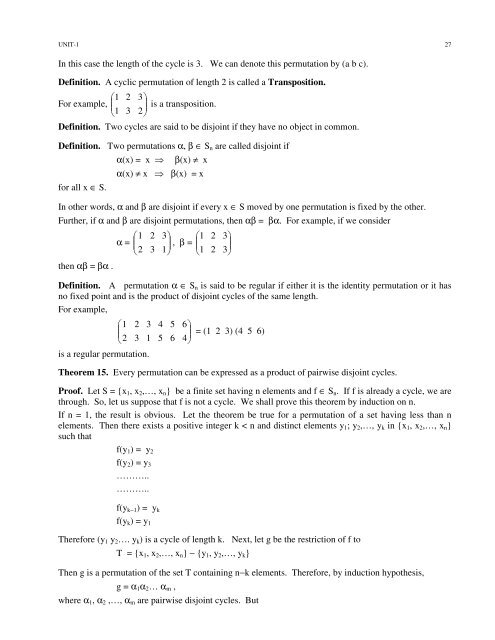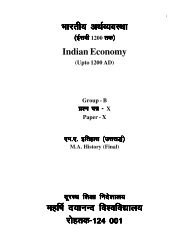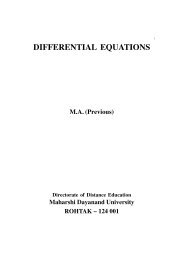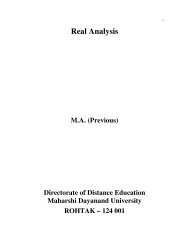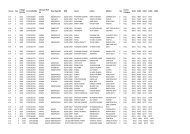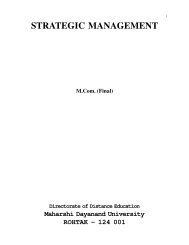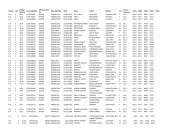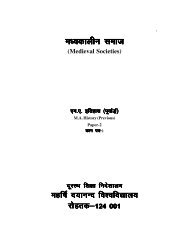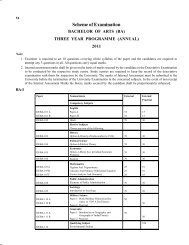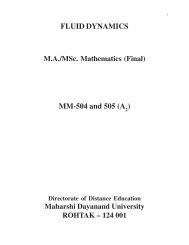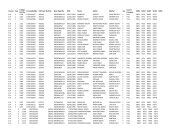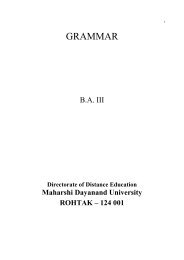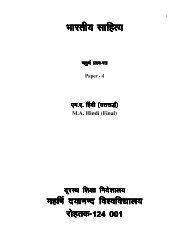Advanced Abstract Algebra - Maharshi Dayanand University, Rohtak
Advanced Abstract Algebra - Maharshi Dayanand University, Rohtak
Advanced Abstract Algebra - Maharshi Dayanand University, Rohtak
Create successful ePaper yourself
Turn your PDF publications into a flip-book with our unique Google optimized e-Paper software.
UNIT-1 27<br />
In this case the length of the cycle is 3. We can denote this permutation by (a b c).<br />
Definition. A cyclic permutation of length 2 is called a Transposition.<br />
1<br />
For example,<br />
<br />
1<br />
2<br />
3<br />
3<br />
<br />
is a transposition.<br />
2<br />
Definition. Two cycles are said to be disjoint if they have no object in common.<br />
Definition. Two permutations α, β ∈ S n are called disjoint if<br />
for all x ∈ S.<br />
α(x) = x <br />
β(x) ≠ x<br />
α(x) ≠ x β(x) = x<br />
In other words, α and β are disjoint if every x ∈ S moved by one permutation is fixed by the other.<br />
Further, if α and β are disjoint permutations, then αβ = βα. For example, if we consider<br />
then αβ = βα .<br />
1<br />
α =<br />
<br />
2<br />
2<br />
3<br />
3<br />
1<br />
2 3<br />
, β =<br />
1<br />
<br />
<br />
1<br />
2 3<br />
Definition. A permutation α ∈ S n is said to be regular if either it is the identity permutation or it has<br />
no fixed point and is the product of disjoint cycles of the same length.<br />
For example,<br />
1<br />
<br />
2<br />
2<br />
3<br />
is a regular permutation.<br />
3<br />
1<br />
4<br />
5<br />
5<br />
6<br />
6<br />
= (1 2 3) (4 5 6)<br />
4<br />
Theorem 15. Every permutation can be expressed as a product of pairwise disjoint cycles.<br />
Proof. Let S = {x 1 , x 2 ,…, x n } be a finite set having n elements and f ∈ S n . If f is already a cycle, we are<br />
through. So, let us suppose that f is not a cycle. We shall prove this theorem by induction on n.<br />
If n = 1, the result is obvious. Let the theorem be true for a permutation of a set having less than n<br />
elements. Then there exists a positive integer k < n and distinct elements y 1 ; y 2 ,…, y k in {x 1 , x 2 ,…, x n }<br />
such that<br />
f(y 1 ) = y 2<br />
f(y 2 ) = y 3<br />
………..<br />
………..<br />
f(y k−1 ) = y k<br />
f(y k ) = y 1<br />
Therefore (y 1 y 2 …. y k ) is a cycle of length k. Next, let g be the restriction of f to<br />
T = {x 1 , x 2 ,…, x n } − {y 1 , y 2 ,…, y k }<br />
Then g is a permutation of the set T containing n−k elements. Therefore, by induction hypothesis,<br />
g = α 1 α 2 … α m ,<br />
where α 1 , α 2 ,…, α m are pairwise disjoint cycles. But


